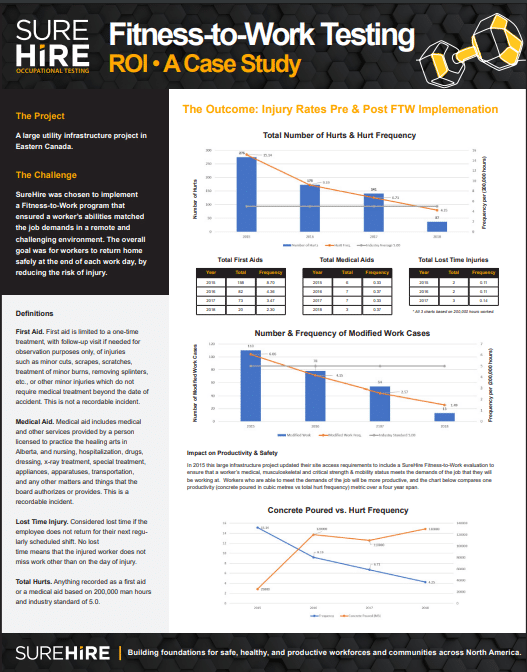TAKEAWAY: Occupational testing is fraught with commonly held myths. Discover the facts and debunk the common myths.
Table of contents
Occupational testing is fraught with commonly held myths. These may come from a lack of understanding of the benefits of testing or how the testing process works. Some categories, such as drug testing, are nuanced because several factors can affect results, which can lead to misconceptions. In this article, we highlight myths in four occupational testing categories:
- drug testing,
- fitness for work testing,
- audiometric testing,
- and lung testing.
Drug Testing Myths
1. Employees cannot decline a drug test.
Yes, employees can decline a drug test. An employer or potential employer cannot demand that their employees complete a drug test. However, a potential employer can refuse to offer someone a job on a test refusal basis. Similarly, an employer can terminate an employee for refusing a test. Here’s the crucial element: workplaces must have clearly defined workplace drug and alcohol testing policies and procedures shared with employees.
2. Scheduled periodic testing is the only type of testing allowed in the workplace.
Several situations warrant the use of drug testing. These include pre-employment testing, post-accident testing, return-to-work testing, random testing, and reasonable suspicion testing. Employers must understand any drug testing laws that may affect them. The company’s drug and alcohol policy should detail the various types of drug testing used in the workplace.
3. It’s easy to cheat on a drug test.
Sure, there are ways to generate a false negative testing result. However, trained testers watch out for signs of manipulation, including urine dilution. Signs of manipulation may be the catalyst for more extensive testing to reveal drug use. The best way to ensure a negative result is to avoid using drugs.

What are Your Provider’s Adulteration Prevention Protocols?
SureHire’s drug testing process involves a series of protocols that aim to safeguard against specimen adulteration, from mouth rinses to dilution logs, and more. In fact, these safeguards have led to a 99%+ accuracy rate among our last 230,000 tests.
Our knowledgeable team of experts works diligently to make sure our clients get fast, accurate results. Find out why thousands of companies across North America trust SureHire as their partner in occupational health testing.
4. There is a high chance of testing positive if I’ve eaten poppy seeds or inhaled second-hand marijuana smoke.
After eating poppy seeds, a false positive drug test is possible, but it’s not likely without consuming a high quantity of unwashed poppy seeds. A second drug test can confirm that poppy seeds were the problem in such cases. Similarly, second-hand inhaled marijuana is unlikely to produce a positive result unless the non-smoker has spent hours inhaling second-hand smoke in an unventilated room. [Find out more about drug testing myths in “Pot Topics: Drug Testing Myths Exposed”].
Fitness to Work Testing Myths
1. Fitness-to-work testing discriminates against people with disabilities and/or physical ailments.
Appropriately conducted, fitness-to-work testing does not discriminate against people with disabilities or physical ailments. A well-implemented fitness-to-work testing program should help employers provide accommodation for potential or current employees with physical limitations.
2. Fitness-to-work testing costs too much and takes up too much time.
Time and monetary investments involved with fitness-to-work testing should be far-outweighed by the corresponding benefits. Costs associated with a poor hiring decision can prove to have a far more significant impact on the business’s bottom line. These costs may be related to decreased productivity and additional training and recruitment requirements.

Fitness-to-Work Testing Case StudyOne of our clients with a large utility infrastructure program in Eastern Canada used our Fitness-to-Work program to ensure workers’ abilities matched the job demands in a remote and challenging environment.
The overall goal was for workers to return home safely at the end of each workday, by reducing the risk of injury. The results were outstanding, and the data speaks for itself.
3. You cannot carry out fitness for work testing for current employees.
Employers can arrange fitness-for-work testing either for the pre-employment process or during employment. Employers can determine when to carry out fit-for-work testing for employees. For example, after a leave of absence or when there has been a significant change in working conditions.[Find out more about fitness to work testing and how to prepare for fitness to work testing].
Audiometric Testing Myths
1. Audiometric testing is only necessary when the employee indicates difficulty hearing.
No is the short answer to this. A proactive approach to audiometric testing is crucial for the early detection of noise-induced hearing loss (NIHL). Early detection is vital to identify the causes of NIHL and avoid further damage. A proactive approach lays the foundation for a pathway to preventing workplace-related NIHL.
2. Audiometric testing only needs to be done once.
Hearing loss from excessive noise exposure is usually gradual, so testing shouldn’t be a one-off exercise. Two types of audiometric testing form a proactive approach. The combination of baseline and periodic audiometric testing allows employers to make informed decisions to take the necessary actions for employee health and safety. [Find out more about employer responsibilities in “How to prevent occupational hearing loss”].
3. Employers cannot do much with the results from audiometric testing at a company-wide level.
Occupational hearing loss is a permanent condition, which is why a proactive approach to testing is crucial. Employers can avoid damage in the first place and use testing results to prevent further hearing deterioration. Results allow employers to create an action plan to reduce noise exposure and protect hearing, for example, through custom earplugs.[Find out more about audiometric testing].
Lung Health Testing Myths
1. Shaving for a mask fit test is unnecessary.
Respiratory Protective Equipment (RPE) is an essential safety item for employees in specific industries and job roles. There is little point in this equipment if it does not fit well, and facial hair breaks the critical seal required for proper testing and protection. Mask fit testing helps prevent substance inhalation that could compromise a person’s airways or lead to respiratory illness. It is one of many things employers can do to help ensure the safety of employees and prevent legal ramifications. [Find out about respirator (mask) fit testing].
2. Lung health testing only needs to be done once.
As is the case with audiometric testing, employers should adopt an ongoing approach to lung health testing. The combination of baseline and periodic tests can help employers identify and accommodate any pre-existing risks and monitor changes to a worker’s lung health over time.
3. Spirometry is the only testing option to determine lung health.
Spirometry is the most common form of lung function testing, but it is not the only way to build a picture of lung health. Spirometry is standard because it is the most straightforward test to assess lung function, and it can form one part of a workplace lung health monitoring program. Other aspects may include chest x-rays, health questionnaires, and physician interpretation. Exercise stress tests such as VO2 max tests determine a person’s cardiovascular fitness and provide insights into a person’s lung health. [Find out more about Surehire’s lung health testing services].

Have additional questions?
Our team is here to answer your questions. Connect with us today!
You May Also Be Interested In…
- Do You Have Reasonable Suspicion?
 Employers cannot initiate reasonable suspicion testing without first going through the 5-step process. Reasonable suspicion training provides critical information about how to initiate reasonable suspicion testing, including the 5-step process and other tools that employers can use to help manage the misuse of alcohol and drugs in the workplace.
Employers cannot initiate reasonable suspicion testing without first going through the 5-step process. Reasonable suspicion training provides critical information about how to initiate reasonable suspicion testing, including the 5-step process and other tools that employers can use to help manage the misuse of alcohol and drugs in the workplace. - An Employer’s Guide: What You and Your Employees Need to Know About DOT Drug & Alcohol Testing
 When implementing or maintaining DOT Drug & Alcohol testing, there are key areas that employers should consider.
When implementing or maintaining DOT Drug & Alcohol testing, there are key areas that employers should consider. - SureHire Occupational Testing Acquires COHR Health: A Positive Step Towards Safe, Healthy, Productive Workforces and Communities
 We are thrilled to announce that today, May 6, 2024, SureHire Occupational Testing has officially acquired COHR Health, a well-known leader in occupational health services. Read on…
We are thrilled to announce that today, May 6, 2024, SureHire Occupational Testing has officially acquired COHR Health, a well-known leader in occupational health services. Read on… - Occupational Testing Use Case – Mining
 In this case study, we will explore how mining companies can use various types of occupational tests to reduce Total Recordable Incident Rates (TRIR) long term.
In this case study, we will explore how mining companies can use various types of occupational tests to reduce Total Recordable Incident Rates (TRIR) long term. - 9 Strategies to Keep Workers Cool on Drilling Sites During Hot Summer Months
 This article delves into strategies to keep workers cool and safe on drilling sites during the hot summer months.
This article delves into strategies to keep workers cool and safe on drilling sites during the hot summer months. - Hearing Conservation Basics: How to Manage Occupational Noise
 Learn how to proactively mitigate occupational noise risks and help prevent NIHL among workers.
Learn how to proactively mitigate occupational noise risks and help prevent NIHL among workers.

